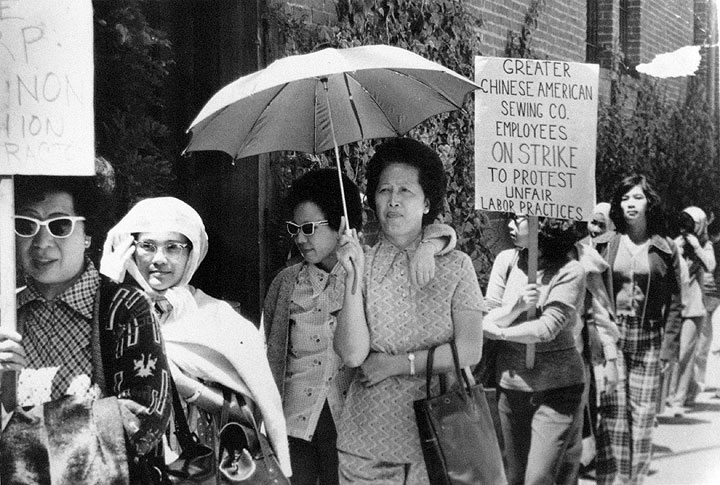
For Asian Pacific American Heritage Month, the AFL-CIO is spotlighting various Asian Americans and Pacific Americans who have worked and continue to work at the intersection of civil and labor rights. Our next profile is about the Jung Sai Garment Work Strikers.
In the late 1960s and early 1970s, San Francisco's Chinatown was a hotbed of garment manufacturing. Large companies handled the purchase of materials, the design of garments and the cutting of textiles. Contract shops, which used largely immigrant labor, handled the assembly work, sewing and cutting. Manufacturing companies pressured the contractors for low bids, and since entry into the industry was relatively cheap, an oversupply of contractors meant that the companies had the upper hand in any labor disputes. If a contractor paid its workers higher wages, the manufacturers would just go to other contractors who paid lower wages.
The system also allowed the manufacturers to avoid any blame for the sweatshop conditions in the contractors' factories. The International Ladies' Garment Workers' Union (ILGWU), the forerunner of UNITE HERE, attempted to organize the seamstresses in San Francisco in the 1960s, but had limited success. By 1973, the garmet industry was cited by the then-called California State Division of Industrial Welfare, with a one-week probe finding more than 600 violations in just 92 shops in the Bay Area. Many of the contractors were aware of the loopholes that allowed them to evade compliance with state labor law.
The Jung Sai factory was a large plant in Chinatown that in the early 1970s was owned by Esprit de Corp, a company that made clothing for young people. Work in the factory was plagued by harassment, intimidation, speed-ups, lack of breaks, low wages and disrespect for the workforce that consisted largely of Chinese immigrant women. The factory was owned by Douglas Tompkins, who was strongly anti-union. Among the worst violations were daily rationing of toilet paper to two roles for 135 employees and the firing of workers with experience and replacing them with cheaper workers with less skill. Workers who showed they had skills in English were fired and workers were rarely, if ever, allowed to talk with white, non-Chinese speaking management.
On July 4, 1974, four workers (Lily Lee, Lam Bick Chung, Nam Hing Leung and Frankie Ma) began distributing and collecting union authorization cards. While most workers were supportive, management hit back hard. Ma, notably the best of the pro-union leaders in terms of speaking English, was fired within the week. Workers were subjected to psychological pressure and retaliation. Tompkins held a meeting to inform the workers of his position on unionization and the workers' demands. The meeting was filled with threats and offers of higher pay for abandoning unionization. The next day, the workers voted to strike, and they walked out on July 15. Two days later, Tompkins locked the workers out and closed the factory. Dozens of strikers were arrested, and a driver working for Tompkins hit several protesters with a truck. Police harassed the protesters and refused to call an ambulance until forced to.
On July 24, the workers established a Jung Sai Strike Support Committee that began to meet on a regular basis. The Jung Sai workers expressed solidarity with others in the city fighting back against similar treatment. The strike got support from outside the industry, too, as the struggles of Chinese immigrants was an inextricable part of the story. Among the successful tactics the committee launched was a caravan of 30 cars that drove through the streets of Chinatown telling everyone of the conditions at the factory. News of other strikes around the country were coming fast and furious, with more than 1,000 strikes in 1974 alone. The Jung Sai strikers were part of a nationwide movement, and their action inspired others to stand up for themselves as well.
Tompkins responded with more use of police and the courts to undercut the strike. A sympathetic judge granted the company a restraining order against too many pickets. He also arranged to "sell" the plant to his manager, who would supposedly open up the plant again and rehire not only the strikers but other fired workers as well. Other promises of guaranteed work, improved benefits and higher salaries all turned out to be false.
Esprit de Corp and Tompkins refused to do anything until they were forced to in December 1975. A judge ordered the plant to be reopened, workers hired back and back pay paid out, among other improvements. The average settlement for workers was in the $8,000–$12,000 range. The company used legal maneuvers to delay the payouts for more than four years after the ruling, but eventually it was forced to settle.
Not only did the strike eventually result in gains for the Jung Sai workers, it energized immigrant activism in the Bay Area and beyond, particularly among Chinese immigrants. While the seamstresses at Jung Sai engaged in marches, car caravans, plant shutdowns, community rallies, press conferences, mass media events and an immigrant workers' cultural festival, the rest of the country watched. And many learned from what the Jung Sai strikers did.
Source: "Jung Sai Garment Workers Strike," by Harvey Dong, which appears in Ten Years that Shook the City: San Francisco 1968–1978, edited by Chris Carlsson, 2011.

